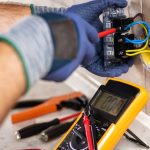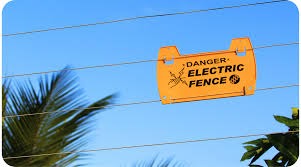Electrical Fence
COC Express (Pty) Ltd performs inspections on the Electrical Fence installations to certify the installation is compliant as per SANS Regulations SANS10222-3: 2011. A Certificate of Conformity will be issued for those installations that fully comply
In South Africa, electric fences are subject to strict compliance regulations governed by the Occupational Health and Safety Act, 1993, and the Electric Machinery Regulations of 2011.
All requirements must also meet the latest SANS 10222-3 safety standards, so that an Electrical Fence COC can be issued
The Importance of a Certificate of Compliance (COC) for Electric Fencing in South Africa
Electrical fencing is a critical component of security infrastructure in South Africa, offering both physical and psychological barriers against intrusion. However, the installation and operation are subject to stringent legal and safety requirements to ensure they are safe, effective, and compliant with national regulations. A key requirement is obtaining a Certificate of Compliance (COC) for electric fencing.
What is a Certificate of Compliance (COC)?
A Electrical fence Certificate of Compliance (COC) is an official document certifying that the installation meets the standards outlined in South African regulations.
The COC ensures that the electric fence installation is safe for humans, animals, and the environment while maintaining its intended security functions.
INSPECTIONS AND COC
Why is a COC a Legal Requirement?
The legal framework surrounding electric fencing aims to:
- Protect public safety:Properly installed and maintained electric fences reduce the risk of accidental harm to individuals or animals.
- Ensure compliance with industry standards:Adhering to SANS 10222-3 and other relevant guidelines guarantees the fence’s effectiveness and reliability.
- Enable property transactions:A valid COC is mandatory when selling a property with an electric fence. Without it, the transfer of ownership cannot proceed.
- Avoid legal penalties:Non-compliance with electric fencing regulations can result in fines, liability claims, or suspension of business operations for installers.
Key Elements Checked During COC Certification
To issue a COC, a qualified and registered electric fence installer inspects the following aspects:
- Fence design and construction: Ensuring the fence is structurally sound and adheres to regulatory standards.
- Energizer compliance: The energizer must meet SANS specifications and be installed correctly.
- Earthing and grounding: Proper earthing systems are critical to prevent accidental electrocution or electrical interference.
- Warning signs: Clear, durable warning signs must be installed at regular intervals.
- Proximity to utilities: Electric fences must maintain safe distances from public utilities like power lines and water pipelines.
- Operational testing: The system must be tested for proper functionality, including alarm triggers and voltage output.
An inspection comprises of the following aspects:
- Wall Height: Minimum wall height of private property to be secured - 1.5 metres
- Bracket: Upright brackets may be used without any height restriction
- Angled brackets: Brackets can be angled at no more than 45 degrees out and are to be installed on the inside of the boundary wall
- Brackets are 3m apart
- Earth spikes are installed every 30 metres
- Lightning Protection is installed with 3 x Additional Earth Spikes
- All HT Cable is Installed conduit with Junction Boxes
- Correct Height of the Energiser
- Warning Signs: Electric fencing installed along a public road or pathway shall be securely identified with YELLOW WARNING SIGNS (100 x 200 cm) at intervals not exceeding 10 meters. All gates and access points to have warning signs
- Electrified Gates: To be capable of being opened/ closed without the person receiving shock.
- Neighbours: It is not permissible to angle brackets into a neighbour’s property without their knowledge or consent.
- Hazard: Electrified fences are to be installed and operated so that they cause electrical hazard or entanglement to persons or animals.
- Barbed wire or razor wire: These shall not be electrified by and energiser.
An inspection comprises of the following aspects:
- Wall Height: Minimum wall height of private property to be secured - 1.5 metres.
- Bracket: Upright brackets may be used without any height restriction.
- Angled brackets: Brackets can be angled at no more than 45 degrees out and are to be installed on the inside of the boundary wall.
- Brackets are 3m apart.
- Earth spikes are installed every 30 metres.
- Lightning Protection is installed with 3 x Additional Earth Spikes.
- All HT Cable is Installed in conduit with Junction Boxes.
- Correct installation height of the Energizer.
- Warning Signs: Electric fencing installed along a public road or pathway shall be securely identified with YELLOW WARNING SIGNS (100 x 200 cm) at intervals not exceeding 10 meters. All gates and access points to have warning signs.
- Electrified Gates: To be capable of being opened/ closed without the person receiving a shock.
- Neighbours: It is not permissible to angle brackets into a neighbour's property without their knowledge and/or consent.
- Hazard: Electrified fences are to be installed and operated so that they cause electrical hazard or entanglement to persons or animals.
- Barbed wire or razor wire: These shall never be electrified by any energizer.
These are just some of the more basic regulations concerning domestic installations.
Certification Process
We trust that we have answered many of your questions and hopefully given you a better understanding and appreciation of the purpose behind these inspections.
Important information
When is an Electrical Fence COC is required:
- Property transfer: You must provide a valid COC when selling your property.
- New installation: A COC is required for any newly installed electric fence.
- Alterations: You need a new COC if you make any modifications or upgrades to the existing system.
- Pre-2012 fences: If a fence was installed before October 2012 and has not been altered, it is exempt from the updated standards. However, if the property is sold or the fence is changed, it must be brought into compliance.
Liability and penalties:
- Property owners without a valid COC can face legal liability for injuries or deaths caused by a non-compliant fence.
- Insurance claims related to the fence may be rejected if you do not have a valid COC.
Maintenance requirements:
Regular maintenance is a crucial part of compliance to ensure the fence remains safe and in good working order.
- Inspections: The SANS 10222-3 standard requires regular inspections, including a monthly visual check and a quarterly test of the voltage and earth resistance.
- Clearance: The fence must be kept clear of vegetation or debris that could cause arcing or reduce its effectiveness.
- Repairs: All faulty components, such as broken wires, insulators, or clamps, must be repaired or replaced promptly.
We perform inspections on the Electrical Fence installations to certify the installation is compliant as per SANS Regulations (SANS 10222-3:2011).
A Certificate of Conformity will be issued for those installations that fully comply.
The Role of Qualified Installers
Only installers registered with the Department of Labour are authorized to issue a COC for electric fencing. Property owners must hire accredited professionals to avoid invalid certifications and potential legal issues.
Failing to obtain or renew a COC for an electric fence can lead to several complications, including:
- Insurance claim rejections: Many insurance providers require a valid COC to process claims related to electric fence failure or accidents.
- Legal liability: Injuries or fatalities caused by a non-compliant electric fence could result in severe legal repercussions for the property owner.
- Halted property transactions: Property sales cannot proceed without a valid COC for the electric fence.
A Certificate of Compliance is not just a legal requirement for electric fencing in South Africa; it is a vital measure to ensure safety, security, and peace of mind for property owners and the public.
By working with qualified installers and adhering to regulatory standards, property owners can avoid legal complications, protect their investments, and maintain the highest safety standards.




